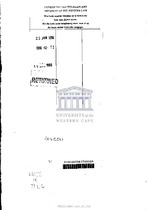| dc.description.abstract | This study is an evaluation of development strategies that have been followed in South Africa. Lebowa is used as a case study for an assessment of the present strategy. The basic question is whether or not it is economically, politically and socially effective to follow the "homeland" development strategy. This approach places "homeland" states within confined political borders. Development policies are also confined to these borders. An alternative is to follow a broader regional development strategy, that spans across both political and economic borders. This may provide a more feasible approach to development. The present regional pattern of development, which focuses
mainly on industrial decentralization, is discussed. The evaluation of the present strategy explores various other alternatives which may provide for a more effective regional development policy. In this context an assessment of 'backward regions/homelands' is provided. The central problem addressed is the country or 'homeland' versus regional orientation. To understand the problem, the core-periphery view on South Africa's regional growth pattern, is utilized. The PWV, Durban/ Pinetown and the Cape metropole areas may be taken as "core", where most of the economic activity takes place. One can also distinguish between the "inner-periphery", which is close to the core, and the "outer-periphery", further away from the core and which includes the Black Homelands. This core-periphery approach provides an understanding of the polarisation effect, which results in the "homelands" becoming poorer, whilst the urban areas grow richer. The main criticism of the of
the modernisation or diffusionist approach is that the "trickle-down" or spread-effect from the core to the other regions does not really take place. Thus, regional aspirations are not satisfied. The South African Government's attempts to counter some of the forces of
concentration have been questionable. Within the context of the diffusionist paradigm, trickle-down effects have not occurred because of the super-imposition of a political ideology onto this approach. Rather these areas are the result of polarization (re-inforced by political
consideration) brought about by the concept of separate development. It is clear that South Africa's approach to regional development is in a process of change. This is mainly due to the failure of the "homelands" strategy. Since the mid 1970's it has become increasingly clear that the "homelands" could not really become economically independent (and internationally recognised), and development strategy concentrating on each that the uneconomic and inefficient."homeland" would be uneconomists critical of this unified economy. planners and politicians. approach have suggested that the whole South African economy should be planned as one economy, even if the homelands still maintain political independence. The nine development region mapping of South Africa, Regions A - J, came about as a result of attempting to address South Africa as a more unified economy. Up to now, the proposed role of the regions have not been clearly stated | en_US |

